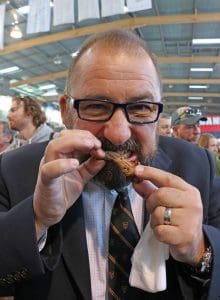LAMB is winning over a whole new generation of US consumers chowing down on a mix of ethnic cuisines and street food.
International chef Neil Doherty said lamb’s market penetration in the US casual dining market had jumped by eight percent to a total of 20pc in the past four years.

International chef Neil Doherty tries a lamb chop at Lambex 2016
It ranks third in popularity behind pulled pork on 21pc growth and tofu on 19pc.
Mr Doherty, Sysco Corporation director of culinary development, told delegates at LambEx 2016 yesterday that fast casual dining now comprised 65 percent of the US market in volume. The LambEx 2016 Conference was held at Albury, NSW, on August 10-12.
Mr Doherty said “superstar chefs’’ were opening fast/casual restaurants based on margin and volume rather than concentrating on fine dining.
He is working with US restaurant chains on evaluating a Mediterranean style lamb burger for their menus.
Mr Doherty said the US prejudice against lamb since World War II was fast disappearing.
“We have an entire generation of millenials (18 to 34 year-olds) willing to try anything and who have no anti-lamb sentiment so lamb is becoming on trend,’’ he said.
“It’s not lamb racks but pizzas and meatballs.
“Americans are no longer eating boring style food – they are totally into flavours.’’
Ethnic cuisine, crossovers, mashables and street food are in vogue – a perfect fit with lamb.
Sysco sourced 4628 tonnes of lamb last year for their restaurants and specialty retailer customers, with 37.7 per cent sourced from Australia as legs, shanks, loins and racks.
The company turned over $48 billion in food product sales in 2015 to almost half a million customers, and Aussie lamb is firmly on its radar.
Mr Doherty said demand was growing and more Australian packaged product would be required.
In Australia, Sysco sources product from Foodcomm International, Thomas Foods International, The Lamb Company and Pilot Trading.
“Lamb is trending but in a different way than what we are used to,’’ Mr Doherty said.
In the past, lamb was almost exclusively marketed into the fine dining sector, comprising just five percent of the total US food service market.
“The rack of lamb was always the anchor item in fine dining during the 1980s,’’ Mr Doherty said.
“Top New York restaurants are now using lamb in a different way.
“Shanks are a big item – chefs are transforming secondary cuts and have a story to tell the customer.
“In Sydney I had a pulled lamb shoulder that was absolutely phenomenal, so I will go back to the US to see what we can do with shoulder.
“Our chefs are already trained on how to slow braise, barbecue pulled pork so why can’t we do something in lamb with a multi-cultural relevance?
“A lamb shoulder can be served as four to five different ethnic (dishes).’’
Over the past four years, quick serve restaurants have increased their lamb use on menus by 11 per cent and family casual operations by 12pc, while other segments remained stable.
As a result, lamb is now appearing on 20pc of menus across the US.
Mr Doherty said lamb needed to capitalize on the buzzwords of natural, sustainable and small farm.
“The average punter is now asking questions about their food – 10 years ago they just went in and got a burger.’’
Mr Doherty said the growth in lamb was testament to a growing demand for “clean, green’’ products from diners – grass fed, natural, no anti-biotic use and are organically certified.
“Lamb ticks these boxes for a chef and their customers.
“While all indicators are generally positive for Americans to incrementally continue to eat more lamb, price, quality and sustainability will remain key ingredients in ensuring a healthy future for Australian lamb in the US.’’
- Come back on Monday for more LambEx coverage on Sheep Central.

HAVE YOUR SAY